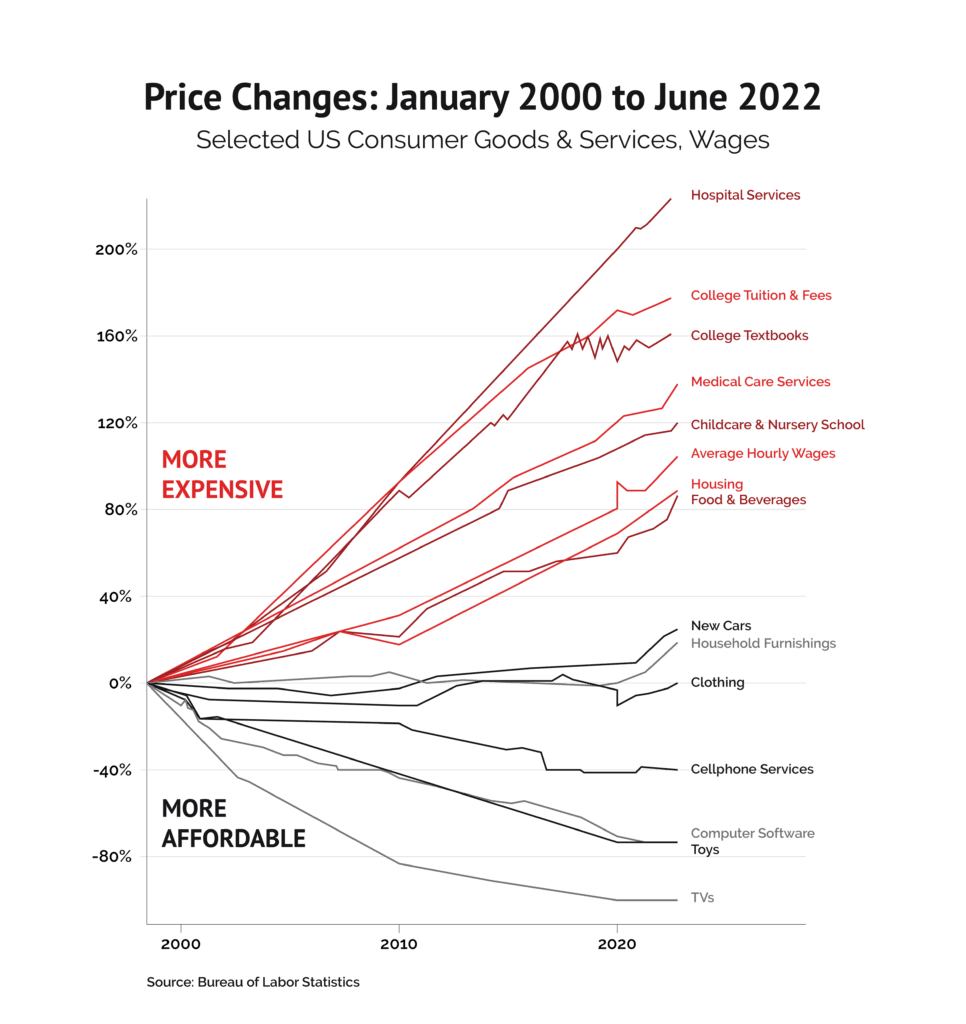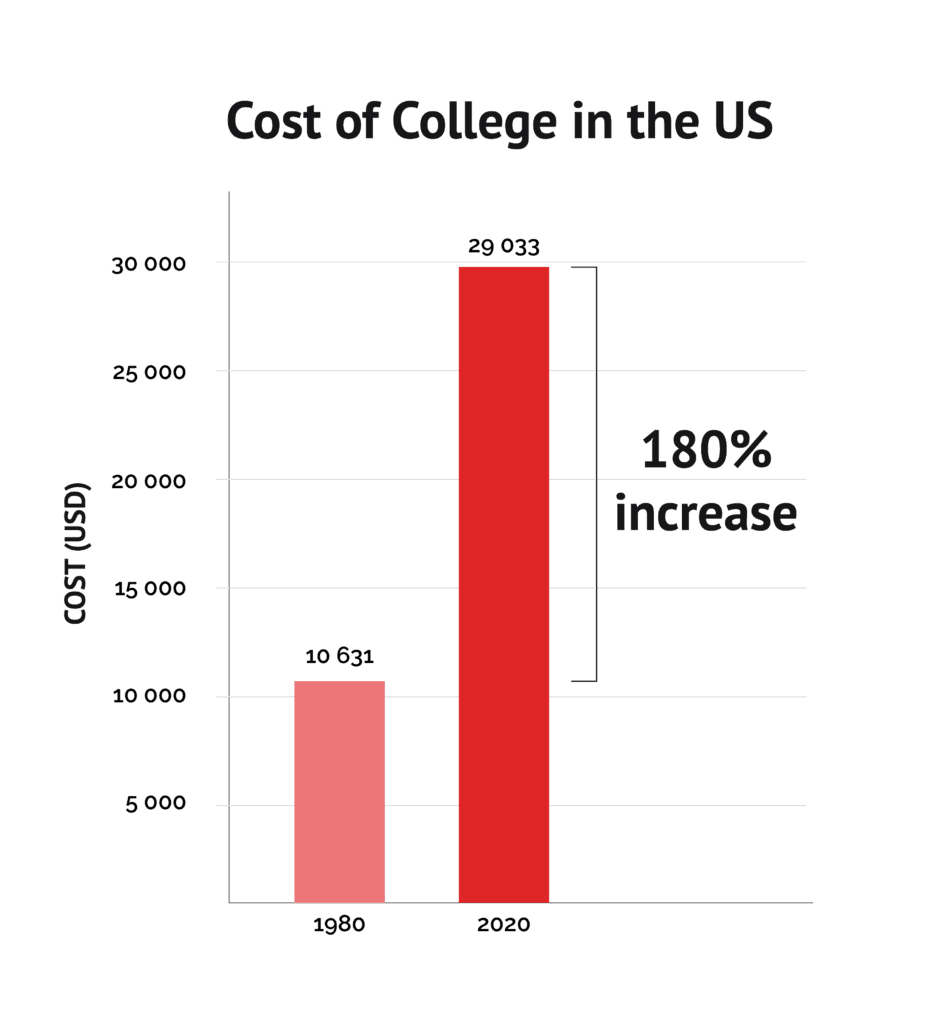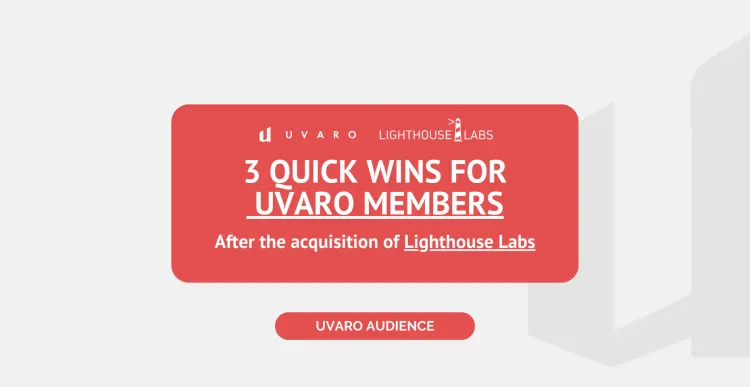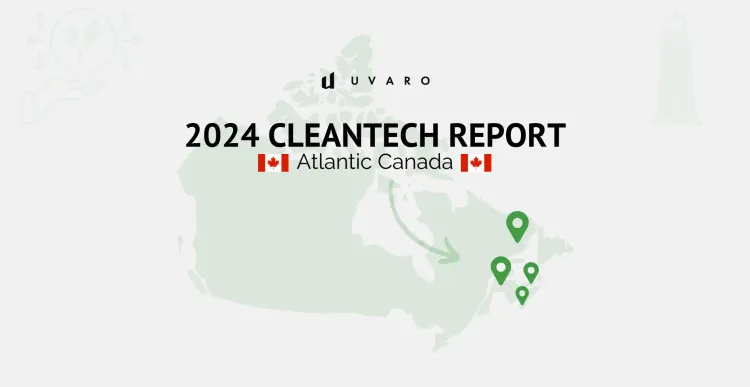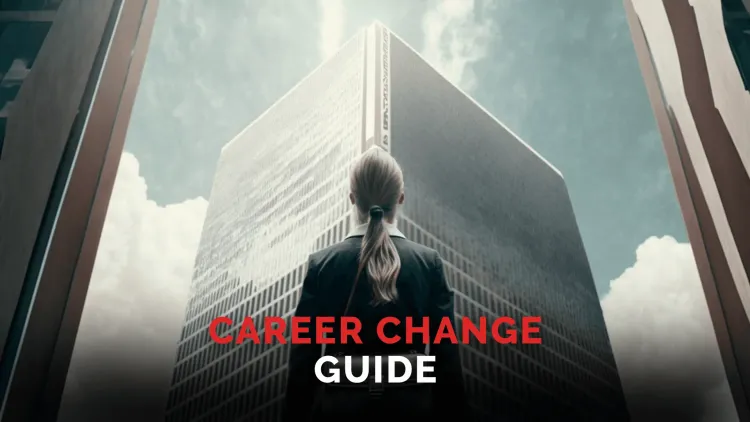1982 - Present: Inflation Vs The Cost Of A College Degree | Why The Dramatic Increase?
Trends in global economic inflation have had a big impact on rising costs for higher education. What does this mean for college costs?

Aug 23, 2022
You’ve watched gas prices skyrocket. A loaf of bread now costs a million dollars compared to the 80s. You might even remember when you could go to the convenience store with a single dollar and come home with an assortment of treats.
But inflation hasn’t just affected your day-to-day necessities.
College tuition has been silently and steadily on the rise since 1980. Widely cited statistics show that college tuition has been rising far faster than inflation.
The average cost of attending a traditional 4-year college has been rising more than twice the rate of inflation. According to data from the National Center for Education Statistics, the tuition and boarding fees for the 2018/2019 academic year were as follows:
- $18,383 at public institutions
- $27,040 at public for-profit institutions
- $47,419 at private non-profit institutions
In comparison, data from NCES shows that in 1985 public institutions cost $8,312, while private non-profit institutions cost $20,678. Fees have more than doubled.
Why have college costs outpaced inflation?
Take a deep dive with me into the role inflation plays in the rising college costs over the years and how they’ve changed.
What Is the College Tuition Inflation Rate?
Let’s start with the basics. Inflation is the gradual increase in prices and slow decline in purchasing power of the dollar over time. In human terms, this means stuff costs more, and the value of your money goes down. When both those things happen at once… well you can see the problem there.
The general inflation rate for consumer prices in the US moved over the past 61 years between -0.4% and 13.5%. This means that over the last 61 years, your dollar value has gone up, and down dramatically like a little rollercoaster of financial disparity and prosperity.
For July 2022, the general inflation rate was calculated at 8.5%, a slight decline from June when inflation hit 9.1%—the highest recorded in 2022. But in general, tuition increases at about 2x the rate of inflation. Meaning, while all of us are living at 8.5%, college tuition would be at a whopping 17%.
In the 80s, a college student could attend a 4-year program for around $10,000 a year. By 2019, the total cost increased to over $30,000 which is MIND BOGGLING.
Data from the Commonfund Higher Education Price Index shows that inflation for U.S. colleges and universities rose 1.9% in 2020. Ultimately, the average cost of college tuition in the U.S. has increased by more than 144% since 2001.
How Does Inflation Affect College Tuition Costs?
When the costs of goods increase due to inflation, education institutions offset the balance by raising the tuition.
Think of all the things that make a school run: Books, stationary, building maintenance, employee salaries and benefits, equipment, accessibility costs, etc… If those cost more, then it only makes sense that tuition fees rise to help cover those costs. The Higher Education Price Index (HEPI) measures the relative changes in product prices that allow colleges to stay in the green. It used to cover over 100 items, but now covers a series of categories.
The HEPI, however, doesn’t align with the Consumer Price Index (CPI). This makes it difficult to make a clear comparison between rising tuition and changes in inflation since the HEPI is affected by many other factors outside the cost of goods. Salaries and the cost of labor fluctuate differently than other simple costs and can greatly affect the HEPI in the way it doesn’t for the CPI.
Why Is the Cost of College Rising?
There are many other factors that can cause the cost of college — tuition, board, room, and fees — to rise. The following things can be connected to the rise of inflation as inflation is a key part of the economic structure.
1. Reduced State Funding
In 2017, the Cato Institute discovered that 57% to 68% of tuition fee increases were attributed to state funding reductions.
Deep state reductions in funding for higher education over the last decade have contributed to significant tuition increases, pushing more of the cost of college on students.
The state funding for public 4-year colleges in 2018 was more than $6.6 billion below what it was before the Great Recession. After the recession, colleges responded to government funding cuts by increasing tuition, limiting course offerings, reducing faculty, and in some cases closing some campuses.
It really puts the onus on the individual to be entirely responsible for their education costs causing more stress on students than their actual academic performance. This forces students to prioritize paying for their education over learning.
2. Demand
Usually, as demand increases, so does the price. For example, more than 5 million more students enrolled in US colleges in 2017 than in 2000 and the tuition cost rose significantly higher in parallel.
However, college enrollment has been on the decline since 2018 as more people question the value of a 4-year degree amid rising tuition costs and changes in the job market. In 2019, for instance, total undergraduate enrollment decreased from 17.5 million to 16.6 million.
It seems paradoxical, but while higher education becomes more exclusive and elitist, tuition fees go up. While the demand may fluctuate, the supply remains the same. This means that all the costs required to maintain a functioning college — including the variety of classes offered — remain and tuition needs to rise to stay afloat.
This becomes a cycle: students who can afford the fees continue to enroll for classes while those who can’t fall away, ensuring that a variety of classes still need to be offered but without the enrolment rates needed to meet growing costs of supplies and salaries, tuition fees are increased to make up the difference.
3. More Federal Aid
The lesser known 1987 Bennet Hypothesis 2.0 postulated that educational institutions will raise tuition costs when financial aid increases. In other words, colleges can increase tuition because the government will cover the expenses. In theory, students can offset the costs with federal aid and it’s a win-win.
Does the Bennet Hypothesis apply today?
The New York Federal Reserve conducted research that supports the hypothesis. It was found that an increase in federal student loans led to a corresponding rise in college tuition fees over the past 15 years.
But students will still be paying the same amount of money, and an increase in student loans means they will remain in debt for much longer. Raising tuition costs in this way doesn’t actually offload onto the government. It’s not a workaround for a lack of educational funding on the federal level. Those costs still, ultimately, default to the student.
How College Tuition Has Changed in the Last 40 Years
Between 1982 and 2020, the average cost of college tuition increased exponentially.
Data from National Center for Education Statistics shows that the cost of attending a 4-year college in the U.S. has increased from $10,631 to $29,033 in the last 40 years. That’s a monsterous 180% increase!
College prices have increased across all institution types, but private institutions continue to cost more than their public counterparts. A full-time student paid $48,965 at a private college in the 2019/20 financial year compared to $21,035 at public institutions.
That upward trend has slowed since. Between February and March 2022, tuition only increased by a negligible 0.2%, which continued at the same rate through April. But the fact remains that tuition costs have reached a level that makes students — and their parents — question whether attending a 4-year college is worth the stress and financial burden unless there is a significant decrease in tuition costs.
Do Educational Resources Mean Additional College Fees?
College Textbooks
College textbooks prices have been rising since the early 2000s. According to a recent NBC report, the cost has risen at a rate of 1041% from 1977 to 2015.
The College Board estimates that the average student in the US spends around $1,200 a year on books and suppliers. A single college book can cost as much as $200. According to a 2013 study from the US Government Accountability Office, the cost of textbooks rose 82%, nearly three times the inflation rate between 2002 and 2013.
Surprisingly, the cost of textbooks has continued to increase since then.
In a PIRG survey of more than 2,000 students, 65% of the respondents said they had decided against buying textbooks because they were too expensive. Nearly half of the students said the cost of books had an impact on which classes they took. Imagine taking a class without any of the materials?
Today, book prices have increased faster than tuition, adding to the financial burden that many students are still struggling with.
Internet Access
Contrary to the price of textbooks, as the internet speeds have skyrocketed with the rise of 5G and allowed users to take advantage of data-intensive services, the price per megabit per second has reduced.
According to the U.S. Bureau of Labor Statistics, internet prices are 19.39% lower in 2022 than in 1997. Internet services experienced an average yearly inflation rate of -0.86%. An internet plan costing $50 in 1997 would cost $40.31 today for an equivalent purchase.
The internet has made it possible for anyone to study online and get a degree anywhere in the world. It has increased access to information, making information that’d otherwise be accessible via textbooks readily available online.
As such, to many, a 4-year college isn’t worth it. Anyone with an internet connection can enroll in an alternative program that takes less time to complete at a fraction of the college costs. With a degree meaning less and less on the job market, you can gain the knowledge needed to secure the career of your dreams on your own schedule, from the comfort of your own home.
This begs the question? With the decreasing cost of the internet and the rising cost of tuition and books, is college still worth the cost in 2022?
The ever-growing tuition costs and required additions like textbooks make enrolling in a 4-year college incredibly expensive. Sounds hopeless? DON’T WORRY. College or university isn’t the only path to a high-paying and satisfying career.
Depending on your career goals, you could enroll in a technical or vocational training program at a fraction of the cost of college. Uvaro’s courses run as short as 4-weeks and equip you with the skills, knowledge, and connections you need to land the job of your dreams.
Check out our Career Success Catalog to learn more about our Courses, Workshops, tools, and career services and to join a network of people ready to help you reach your potential.
Tech Sales Foundations (12 Week)
For 12 weeks, 2hrs daily, seasoned instructors will work with your cohort to teach all the skills needed for a successful career in B2B tech sales. You’ll also get 5+ hours of guided independent study with cutting-edge tools.

